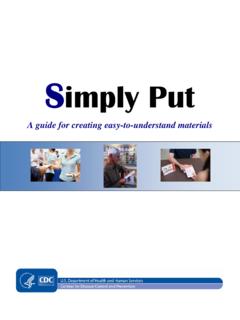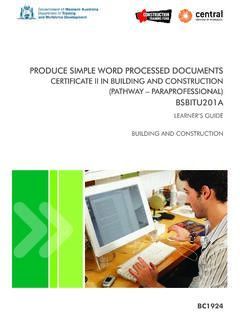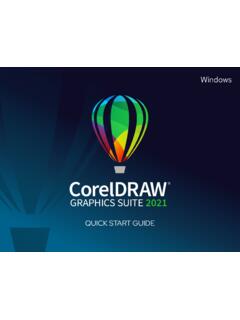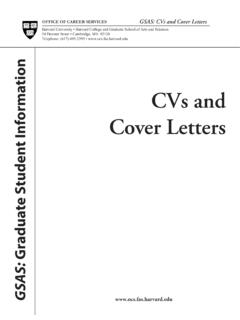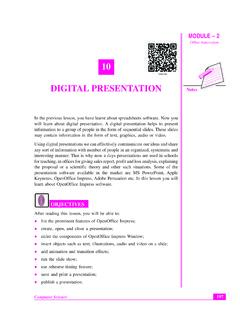Transcription of NATIONAL AERONAUTICS AND SPACE ADMINISTRATION …
1 NATIONAL AERONAUTICS AND SPACE ADMINISTRATION (NASA) ** GUIDEBOOK FOR PROPOSERS RESPONDING TO A NASA NOTICE OF FUNDING OPPORTUNITY (NOFO) Revised as of February 4, 2021 Effective as of February 15, 2021 1 TABLE OF CONTENTS Preface 1. Introduction to NASA s Programs 2. Proposal Preparation and Organization Submission Guidance Submission Requirements and Restrictions Notice of Intent (NOI) to Propose Submission Process Successor Proposals Standard Proposal Style Format Overview of Proposal Required Proposal Elements Certifications, Assurances, Representations and Sample Agreements Proposal Summary/Abstract Data Management Plan Table of Contents Scientific/Technical/Management Plan References and Citations Biographical Sketch Current and Pending Support Statements of Commitment and Letters of Resource Support Proposal Budget with Budget Narrative and Budget Details Facilities and Equipment Table of Personnel and Work Effort Special Notifications and/or Certifications Assembly of Electronic Proposals NASA Requirements for Uploaded PDF Files 3.
2 Proposal Submission NSPIRES Registration Requirements and Instructions Submitting Proposals through NSPIRES Submitting Proposals through Other Submission Options Proposal Receipt 4. Proposal Review and Selection Administrative Review Technical and Programmatic Review Selection Based on Technical Merit Budget, Cost Analysis and Financial Withdrawal of Proposal Proposal Rejected by NASA without Review 5. Award Notification 6. Award Management Appendix A Statement of General Policy Appendix B Definitions for Organization and Personnel Appendix C Costing Details 2 Appendix D Proposal Processing, Review and Selection Appendix E - Conflicts of Interest for NASA Peer Reviewers Appendix F- Security Request Appendix G Multi-Year Funded Awards Appendix H Appealing NASA s Decision to Decline a Proposal for Financial Assistance Appendix I Guide to Key Documents Appendix J Intellectual Property Appendix K Publishing Datasets on the NASA Open Data Portal 3 PREFACE The Guidebook for Proposers Responding to a NASA Notice of Funding Opportunity (NOFO) (hereafter referred to as the Guidebook)
3 Outlines the policies and processes for submitting responses to a NASA NOFO, which are also known as NASA Research Announcement (NRA), or a Cooperative Agreement Notice (CAN). The NRA is used by the program offices to request proposals for basic and applied science and technology research and for science, technology, engineering, and mathematics (STEM) education programs. NOFOs will specify the anticipated award instrument ( , grant and cooperative agreement). All proposers applying to a NASA NOFO should adhere to the guidelines contained in this Guidebook to the extent invoked in the NOFO. NASA NOFOs are located in NASA Solicitation and Proposal Integrated Review and Evaluation System (NSPIRES): and : The order of precedence is the following: 1.
4 Provisions of law 2. Title 2 of the Code of Federal Regulations (CFR) Part 200 3. Title 2 of the Code of Federal Regulations (CFR) Part 1800 4. The NASA Grant and Cooperative Agreement Manual (GCAM) 5. The requirements noted in the NOFO 6. The Guidebook for Proposers NASA recognizes and supports the benefits of having diverse and inclusive scientific, engineering, and technology communities and fully expects the reflection of such values in the composition of all panels and teams, including peer review panels, proposal teams, science definition teams, and mission and instrument teams. Per Federal statutes and NASA policy, no eligible applicant shall experience exclusion from participation in, be denied the benefits of, or be subjected to discrimination under any program or activity receiving financial assistance from NASA on the grounds of their race, color, creed, age, sex, NATIONAL origin, or disability.
5 NASA welcomes proposals from all qualified and eligible sources, and especially encourages proposals from Historically Black Colleges and Universities (HBCUs), Minority Serving Institutions (MSIs), small disadvantaged businesses (SDBs), veteran-owned small businesses, service-disabled veteran-owned small businesses (SDVOSB), HUBZone small businesses, and women-owned small businesses (WOSBs), as eligibility requirements apply. The Guidebook may be reproduced in part or total without restriction. The Guidebook can be found at: NASA Grants Policy and Compliance Branch. 4 1. INTRODUCTION TO NASA S PROGRAMS NASA is an independent Federal agency of the United States ( ) created by the NATIONAL AERONAUTICS and SPACE Act of 1958.
6 NASA has four Mission Directorates, each assigned responsibility for implementing NASA s vision, mission, and values as outlined in the latest NASA Strategic Plan. The Mission Directorates are listed below: Science Human Exploration and Operations AERONAUTICS Research SPACE Technology The Mission Directorates pursue NASA s goals using a wide variety of ground-, aeronautical-, and SPACE -based programs, and any of these may issue NOFOs that will incorporate this Guidebook by formal reference. NASA s Office of STEM Engagement, in collaboration with the Mission Directorates and Offices, issue NOFOs that solicit evidence-based projects that: Foster formal and/or informal STEM education; and/or Contribute to participation by underrepresented or underserved students and education organizations that predominantly (or historically) serve individuals traditionally underrepresented in STEM careers or underserved in STEM higher education, including but not limited to minorities, women, and persons with disabilities.
7 Visit the NASA STEM Engagement website for the most up to date information on performance and priorities: 2. PROPOSAL PREPARATION AND ORGANIZATION Proposers responding to a NASA NOFO are responsible for submitting proposals relevant to the latest NASA Strategic Plan, which is accessible at: If proposed activities are described or understood to be a type of education, proposers are also responsible for submitting proposals relevant to the latest Federal STEM Education Five-Year Strategic Plan, a report from the Committee on STEM (Co-STEM) Education of the NATIONAL Science and Technology Council ( ). The requirements of this Guidebook shall be applicable to the extent invoked by the NOFO.
8 NOFOs may provide other instructions, under which NASA may reject, without review, proposals that do not follow the NOFO instructions. 5 Submission Guidance To assist with the submission of a valid, complete proposal, proposers shall: Carefully read the entire NOFO before preparing the proposals. The NOFO includes but is not limited to, key dates, eligibility, program goals and objectives, funding restrictions, evaluation criteria, and submission information. The NOFO also provides information for points of contact and help desks that can answer questions regarding the NOFO and the submission process. Follow the instructions outlined in each NOFO as NASA is legally obligated to review and select proposals per the published NOFO.
9 Address the objectives listed in the NOFO with an implementation plan that clearly outlines a detailed breakdown of all tasks the proposer will complete by the period of the performance end date. Identify pivotal milestones, knowledge of key publications in the field, and how the proposed activities will extend or build on those accomplishments. If offering innovative work in a new or emerging field, the proposers should strive to balance the provision of tutorial material and the description of new activities. Choose non-color-dependent ways of conveying critical information when designing graphics, as reviewers may not be able to differentiate colors or hues. Propose fresh, new ideas rather than slight modifications of previously submitted proposals.
10 Simply revising a proposal to meet deficiencies identified in a previous review(s) does not guarantee a higher rating or selection of that proposal. Propose costs that are reasonable, allowable, and allocable according to 2 CFR to the proposed work. Be sure that budgets are thoroughly prepared as they shall provide all the details necessary to justify and facilitate an understanding of the proposed costs. During the non-technical review process, NASA may request the proposer to provide additional information to explain specific items of expenses. Familiarize themselves with the proposal submission process and the NSPIRES or websites well before the deadline. If possible, submit proposals well in advance of the proposal submission deadline to minimize the impact of technical difficulties that may arise.










